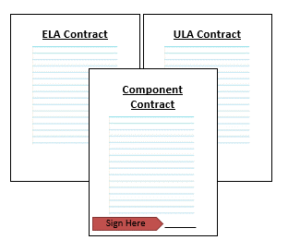- July 30, 2015
- Jeff Lazarto
- Reading Time: 4 minutes
 At some point in your Oracle relationship, Oracle will most likely present you with the option of signing an Unlimited License Agreement (ULA), or an Enterprise License Agreement (ELA), in lieu of their traditional Component-based license agreement. Before you can determine which license model is best for your company, we need to start with an understanding of each Oracle licensing model.
At some point in your Oracle relationship, Oracle will most likely present you with the option of signing an Unlimited License Agreement (ULA), or an Enterprise License Agreement (ELA), in lieu of their traditional Component-based license agreement. Before you can determine which license model is best for your company, we need to start with an understanding of each Oracle licensing model.
Component Based License Model
The Component Based License Model is the default model and the one that is priced according to Oracle’s published price lists on its website. Under the Component model, you purchase the software products and quantities you need based on the license metric and price contained in the price list.
- The metrics can be user based (application user, monitored user, etc.) or business volume based (annual revenue, cost of goods sold, etc.).
- It is a buy-as-you-go license model, priced according to the published price list, with discounts offered based on the list license fee volume of each licensing transaction.
- It is the safest model to prevent overbuying scenarios, but also offers the least amount of discounting and the highest amount of complexity in tracking all of the unique licensing metrics associated with each product.
Enterprise License Agreement
An ELA provides a simpler licensing structure in that all products licensed under the ELA share the same licensing metric, with the most common metrics being annual revenue or the total number of employees. Oracle will propose what we have seen them refer to as a custom bundle, where they will include all products a customer wants to purchase and then assign a single license metric and associated list price, discount, and net license fee.
- As the name suggests, the license metric quantity is determined across the company’s entire enterprise, not just the revenue of the business unit or number of employees actually utilizing the products.
- The discounting tends to be more aggressive under this model compared to the Component model to offset the over-licensing risk, and compliance is simplified with the one license metric.
- Once the license metric is exceeded, additional fees are due and are typically purchased in 10% increments of additional license metric and fees.
Challenges with the ELA are ensuring the business metric used is reflective of the value received and true company growth. Additionally, all product licenses and associated support fees are tied together and cannot be terminated on a line item basis if in the future you decide to discontinue use of a product.
Unlimited License Agreement
The ULA provides a license to use the identified list of products on an unlimited basis for a limited period of time. The pricing determination is very similar to the ELA in that Oracle presents a custom bundle of products with list license fees based on current estimated requirements plus a growth factor, and then discounted based on list license volume.
- The duration is typically limited to 3 years, and the licensing metric can be based on either an enterprise business metric or component-based model.
- A company may deploy as much of the listed products as they need without paying any additional fees for the remainder of the ULA term.
- Once the term expires a certification or true-up process occurs to determine exactly how much of the identified products have been deployed and that becomes the entitled license quantity going forward. There are no additional fees at this time, but additional fees will be charged should those license levels be exceeded in the future.
The risk of the ULA is over licensing by not deploying up to the quantities used as the basis for calculating the ULA price. On the other hand, there are potential benefits if you deploy a greater number of licenses than those used in calculating the ULA price during the term. Discounting varies under this model depending on the client’s unique situation, risk profile, list price, and other strategic considerations, but is typically greater than the Component model.
So how do you decide which is the best licensing model for your company?
There are many factors to consider, but you should start with cost. This becomes a math exercise of pricing out your desired bill of materials using the Component model first, as this is the standard default licensing model. The Component model list price should also be the list price for the ELA, and serves as the foundation for calculating the ULA list price which will include an uplift percentage to account for reasonable anticipated growth over the term of the ULA. From there you can review the discounting and net license fees Oracle is willing to provide for each model.
Once the pricing has been determined you can now consider the value of the other factors under each model, such as:
- Does the simplicity and additional discounting of the ELA, along with the risk of potential over-licensing and tie up of support fees outweigh the Component model’s price and greater flexibility?
- If considering a ULA, are you projecting exponential growth that exceeds Oracle’s built-in growth percentage?
- If you deploy less than the base number of licenses without the growth uplift under the ULA model, will you still be entitled to the base license level at the end of the term?
- Has Oracle included products under the ELA or ULA models that are not current requirements but are strategic to Oracle that they are hoping you will deploy because they are included as part of the deal? Do these models include outer-year requirements where the likelihood and timing of deployment is less certain?
- Does the Component model include competitive future price and discount protections that allow you to buy outer-year requirements at competitive prices when you have more certainty of deployment timing?
- Removing cost considerations, which license model do you prefer? If this is not the lowest cost model, is there an opportunity to negotiate greater discounting to make the cost more attractive?
The evaluation factors and associated weighting will vary for your company based on your unique circumstances and considerations. But the cost analysis will apply to every deal and should serve as the foundation for then factoring in the other elements of each model.
Related Posts
Related Blogs
3 Common Mistakes When Counting Your Oracle Named User Plus License Requirements
NEW: Obtain Oracle SaaS Pricing with Free Estimate Calculator
Oracle Fusion ERP: 4 Key Terms to Negotiate
About the Author
